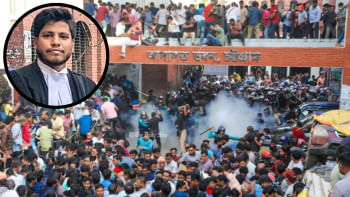The Shrine by The Dighi

Photos: Darshan Chakma
Bangladesh is filled with some of the most beautiful structures and architecture and many of them can be found in locations seldom visited by the Dhaka dwellers, or even by those living in the new formed towns and developing cities. One of the most astonishing structures, by far, is the Khan-e-Azam Khan Jahan Ali Mazar, located in Bagerhat.
Khan Jahan died on 25 October 1459 (27 Dhul Hijjah 863 AH), the year when the mazar was created. The mazar is not only a place of worship, but today the structure stands as a symbol of hope, beauty, a place where many locals come together, enjoy the weather by the dighi (pond) or just to be absorbed by the peace and serenity around. The structure is now maintained by the khadems. "He lived around the time of the Tuglaq reign," says Al Haj Fakir Humayun Kabir, one of the oldest khadems at the mazar. "He would speak of religion, spread the message and wherever he went, he would build a mosque, a dighi, do his wadhu and pray. In Bangladesh alone, there are more than 360 mosques and disghis built by him."

Surely enough, Khan Jahan Ali founded townships, built mosques, madrasahs, roads, highways and bridges, excavated a large number of dighis in the districts of greater Jessore and Khulna.
According to common knowledge and also wikipedia, Khan Jahan Ali built three townships, such as Maruli Kasba, Paigram Kasba and Bara Bazar. He is said to have built a highway from Bagerhat to Chittagong, a 32-kilometre (20 mi) long road from Samantasena to Badhkhali, and a road running from Shuvabara to Daulatpur in Khulna.

Khan Jahan Ali ruled over an area called Khalifatabad (modern day Bagerhat) stretching up to Naldi to the north of Narail. One of the most famous mosques in the world, the Shatgumbaj Mosque or the Sixty Dome Mosque, a notable architectural monument at Bagerhat was built by him. Of the large number of dighis and ponds excavated by him the most notable are the Khanjali Dighi (1450) near his tomb and Ghoradighi, measuring 230 by 460 metres (750 by 1,500 ft) to the west of Shatgumbaj Mosque. Khan Jahan introduced a new architectural style in his buildings, which is named after him. The Khan Jahan style is seen in a group of buildings in the greater districts of Khulna, Jessore and Barisal (Wikipedia).
According to Al Haj Fakir Humayun Kabir, the number of worshippers has increased a whole lot. "I think at least a 100 new worshippers come to the shrine every day," he says. "Some come with the hopes of finding a lost one, some come before exams or office interviews, others just like to come and pray here."

The dighi outside the mazar is said to be the home to crocodiles, which turn up now and then. People are sometimes seen petting them! "The crocodiles are friendly," says Al Haj Fakir Humayun Kabir. "My great grandmother had fought with the crocodiles here! Anybody and everybody are welcome to come and sit by the pond and watch the crocodiles. This place is open to all."
Visitors may visit the mazar, pray here and also take pictures, as long as they don't disturb the peace and the worshippers.


 For all latest news, follow The Daily Star's Google News channel.
For all latest news, follow The Daily Star's Google News channel. 



Comments